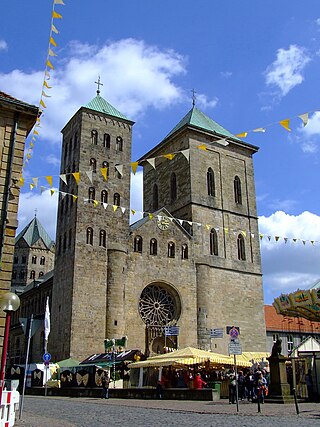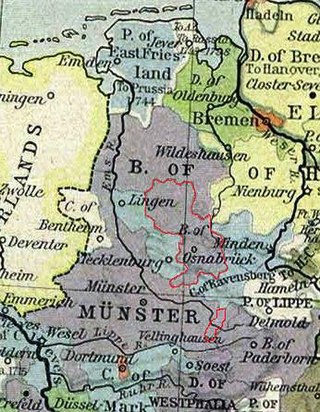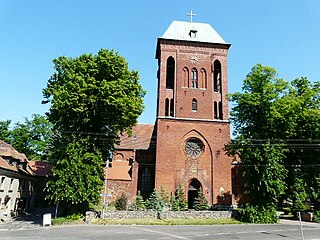
Ratzeburg is a town in Schleswig-Holstein, Germany. It is surrounded by four lakes—the resulting isthmuses between the lakes form the access lanes to the town. Ratzeburg is the capital of the district Herzogtum Lauenburg.

The Prince-Archbishopric of Bremen — not to be confused with the modern Archdiocese of Hamburg, founded in 1994 — was an ecclesiastical principality (787–1566/1648) of the Holy Roman Empire and the Catholic Church that after its definitive secularization in 1648 became the hereditary Duchy of Bremen. The prince-archbishopric, which was under the secular rule of the archbishop, consisted of about a third of the diocesan territory. The city of Bremen was de facto and de jure not part of the prince-archbishopric. Most of the prince-archbishopric lay rather in the area to the north of the city of Bremen, between the Weser and Elbe rivers. Even more confusingly, parts of the prince-archbishopric belonged in religious respect to the neighbouring Diocese of Verden, making up 10% of its diocesan territory.

The Archbishopric of Magdeburg was a Latin Catholic archdiocese (969–1552) and Prince-Archbishopric (1180–1680) of the Holy Roman Empire centered on the city of Magdeburg on the Elbe River.
A Diocesan Administrator is a provisional ordinary of a Catholic particular church.

The Diocese of Osnabrück is a Latin Church ecclesiastical territory or diocese of the Catholic church in Germany. The diocese was originally founded circa 800. It should not be confused with the smaller Prince-Bishopric of Osnabrück–an ecclesiastical principality of the Holy Roman Empire until 1803–over which the bishop, as prince-bishop, exercised both temporal and spiritual authority.

The Diocese of Halberstadt was a Roman Catholic diocese from 804 until 1648. From 1180, the bishops or administrators of Halberstadt ruled a state within the Holy Roman Empire, the prince-bishopric of Halberstadt. The diocesan seat and secular capital was Halberstadt in present-day Saxony-Anhalt.

Evermode, or Evermod, was one of the first Premonstratensian canons regular, and became the lifelong companion of Norbert of Xanten, who founded the order in France in 1120. He is sometimes referred to as the "Apostle of the Wends".

The Archdiocese of Wrocław is a Latin Church ecclesiastical territory or archdiocese of the Catholic Church centered in the city of Wrocław in Poland. From its founding as a bishopric in 1000 until 1821, it was under the Archbishopric of Gniezno in Greater Poland. From 1821 to 1930 it was subjected directly to the Apostolic See. Between 1821 and 1972 it was officially known as (Arch)Diocese of Breslau.
The Vicariate Apostolic of Northern Germany, known for most of its existence as the Vicariate Apostolic of the NorthernMissions, was a Catholic missionary jurisdiction established on 28 April 1667. It belonged to a vicar apostolic in predominantly Protestant Northern Europe.

The Prince-Bishopric of Osnabrück was an ecclesiastical principality of the Holy Roman Empire from 1225 until 1803. It should not be confused with the Diocese of Osnabrück, which was larger and over which the prince-bishop exercised only the spiritual authority of an ordinary bishop. It was named after its capital, Osnabrück.

The Prince-Bishopric of Ratzeburg was an ecclesiastical principality of the Holy Roman Empire that was located in what is today the states of Schleswig-Holstein and Mecklenburg-Vorpommern in Germany. It was established in 1236 and disestablished following the Peace of Westphalia in 1648. The state capital was the city of Ratzeburg. The Diocese of Ratzeburg had originally been established as a diocese of the Catholic Church in the 11th century but had fallen into abeyance; as a result of the Wendish Crusade, the diocese was re-created in the middle of the 12th century. The territory of the prince-bishopric was managed by secular lords on behalf of the Bishop of Ratzeburg. As a Prince-Bishopric of the Empire, the territory of the state was not identical with that of the bishopric, but was located within its boundaries and made up about a quarter of the diocesan area. When the Prince-Bishopric was disestablished, a new entity was established — the Principality of Ratzeburg. The principality became an exclave of the Duchy of Mecklenburg-Strelitz.

The Bishopric of Cammin was both a former Roman Catholic diocese in the Duchy of Pomerania from 1140 to 1544, and a secular territory of the Holy Roman Empire (Prince-Bishopric) in the Kołobrzeg area from 1248 to 1650.

The Prince-Bishopric of Paderborn was an ecclesiastical principality (Hochstift) of the Holy Roman Empire from 1281 to 1802.

The Prince-Bishopric of Lübeck, was an ecclesiastical principality of the Holy Roman Empire until 1803. Originally ruled by Roman-Catholic bishops, after 1586 it was ruled by lay administrators and bishops who were members of the Protestant Holstein-Gottorp line of the House of Oldenburg. The prince-bishops had seat and vote on the Ecclesiastical Bench of the College of Ruling Princes of the Imperial Diet.

The Diocese and Prince-bishopric of Schwerin was a Catholic diocese in Schwerin, Mecklenburg, in Germany. The first registered bishop was ordained in the diocese in 1053, and the diocese ceased to exist in 1994.
Christoph von der Schulenburg was a German nobleman. As bishop of Ratzeburg he converted to Protestantism.

The Diocese of Verden was a diocese of the Catholic Church. It was founded around AD 768 as a suffragan of the Archdiocese of Mainz. It was suppressed in 1648 as part of the Peace of Westphalia. The diocese was centered on the city of Verden an der Aller in what is today the state of Lower Saxony, Germany. The cathedral church of the diocese was dedicated to Ss Mary and Cecilia in 1028 but the building was only completed in 1490. The Bishop of Verden was also, ex officio, the ruler of a principality of the Holy Roman Empire — the Prince-Bishopric of Verden. The territory of the diocese was not identical with that of the prince-bishopric; while the state was located within the boundaries of the diocese, it amounted to less than a quarter of the diocesan territory. Its last bishop was Franz Wilhelm, Count von Wartenberg. Following the Thirty Years' War, Verden, along with the neighbouring sees of Minden and Bremen, fell into the hands of Protestants. Wartenberg was only able to retain the See of Osnabrück.

The Evangelical Lutheran Church in Northern Germany is a Lutheran member church of the Protestant Church in Germany.

The Principality of Ratzeburg is a former state, existing from 1648 to 1918. It belonged to the imperially immediate territory of the Duchy of Mecklenburg within the Holy Roman Empire. It was formed from the territory of the former Prince-Bishopric of Ratzeburg, which was secularised to Mecklenburg-Güstrow in the 1648 Peace of Westphalia. Following the death of the last duke in 1695, the territories of Mecklenburg-Güstrow were split up in the 1701 Treaty of Hamburg, which created the semi-ducal states of Mecklenburg-Schwerin and Mecklenburg-Strelitz, with the latter made up of the Principality of Ratzeburg and the Lordship of Stargard. Its territories remained exclaves of Mecklenburg-Strelitz through its later iterations – the Grand Duchy from 1815 and Free State from 1918 – before the bulk of it was finally incorporated into the unified state of Mecklenburg in 1934 as part of Landkreis Schönberg; its small exclaves were incorporated into Kreis Herzogtum Lauenburg of Schleswig-Holstein. Most of the Principality is now within the state of Mecklenburg-Vorpommern.

In the Holy Roman Empire, the Domfreiheit or Domimmunität was the area immediately around the seat of the Bishop of a cathedral and its cathedral chapter, which was managed by the Domdechant; the English term is cathedral close. This area stretched only a few hundred metres from the outbuildings of the cathedral, at most, and was usually surrounded by a fortified wall (Domburg). They belonged to the secular domain or Hochstift of the bishop.




















